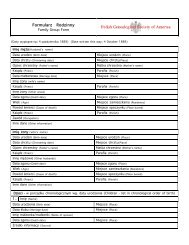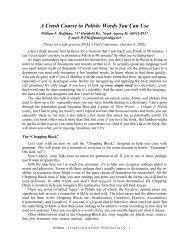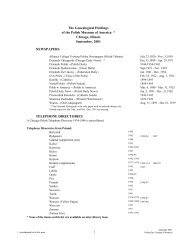Rodziny - Polish Genealogical Society of America
Rodziny - Polish Genealogical Society of America
Rodziny - Polish Genealogical Society of America
Create successful ePaper yourself
Turn your PDF publications into a flip-book with our unique Google optimized e-Paper software.
Ask the RetoucherEric Basir He’s worked in darkrooms—both digital and conventional—newspapers and studios. He runs Photo Grafix, a humblephoto-retouching studio in Evanston, Illinois (USA), helping genealogists restore and preserve photos and documents withtheir computers. If he doesn’t know the answer, he won’t rest until he finds it. Eric Basir is at your service. With each “Ask theRetoucher” column, he’ll help you successfully tackle your digital photographic preservation and restoration problems.Please send your questions and problem photos, your location, and genealogical society affiliation (if appropriate) toquestions@abetterreality.net for future “Ask the Retoucher” columns. You can learn more about Eric and his work online atwww.abetterreality.net. He has also enhanced many <strong>of</strong> the photos in issues <strong>of</strong> <strong>Rodziny</strong>. Thanks, Eric!Question—Tom (USA) asks: “I haveheard about various clear sprays that aredesigned to protect color photos againstUV damage. How effective are these sprays,and can you suggest one or two that workespecially well?”Answer—Tom, I have had no experiencewith any UV protection sprays. I treatUV sprays the same way I do nutritionalsupplements: they might help prevent problems,but—in many cases—they are not asgood as a commonsense diet with exercise.You certainly deserve a more detailedexplanation, since your photos don’t eat ormove. So, a commonsense diet with exercisefor your photos would be:1. Keep them out <strong>of</strong> sunlight. Period.That is, direct or indirect sunlight.2. Keep them behind a glass framewith matt-board.3. Use archival-quality framing materials.4. Keep them away from any kind <strong>of</strong>smoke or moisture.5. Use real photographic prints(which can be done even with digital images).If you use an inkjet printer, useonly the manufacturer’s ink and paper;HP ink and paper for HP printers, forexample.If you do all <strong>of</strong> these things, I don’t believeyou’ll need the UV spray. You will alsosave money, your lungs, and the environmentby not using the spray. Regarding theframe, I highly recommend a pr<strong>of</strong>essionalframing service or archival and/or scrapbooksupply service. They are trained in thelatest archival techniques and use the bestquality supplies. In the worst case, you canpurchase a frame with its own matt-boardfrom a local retail store.Question—Lee (USA) asks: “I have avast amount <strong>of</strong> picture albums that I wouldlove to put on CDs for sake <strong>of</strong> space. WhichCD is the best? The CD-R or the CD-RW? Ihave heard that after a few years they willnot be gone from the CD. Is this true?”Answer—Lee, all recording media evolvethroughout the years. From stone tablets,cave walls, and papyrus to audiocassette,CD, and flash memory, the best way topreserve them is to transfer to the latesttechnology and create multiple copies.This should include digital and hard copy(prints) or analog (tape). It sounds a bitfanatical—having various copies <strong>of</strong> everything—butit’s worth it.Organizing it can become a headache,however. So it’s important to start out withthe basics before establishing an elaboratearchiving system. The most basic systemshould consist <strong>of</strong> an external hard-drivewith almost twice the capacity <strong>of</strong> your computer’shard-drive and a high-quality DVDwriter. First, copy your entire photo archiveonto the external drive. Then, transfer thecollection onto CDs or DVDs, as appropriate.I also recommend you create one extracopy <strong>of</strong> each CD or DVD <strong>of</strong> your photos andstore the extra copies in another locationoutside <strong>of</strong> your home. This process willgreatly reduce the risk <strong>of</strong> losing your collection.I suggest using DVD-R for archivingfamily photos. I’m only recommendingDVD-R because its capacity is six times thecapacity <strong>of</strong> a CD-R. CDs can hold about650 megabytes. DVDs can hold about 4,500megabytes. Besides that, either one shouldwork fine. Avoid using RW (rewritable)media because the surface is not stableenough for archival purposes. The slightestscratch or sneeze might render it useless(smile).I use CD-RW and DVD-RW for sharingfiles and burning MP3s for playing music(which I then later overwrite, since all the14 <strong>Rodziny</strong>, Spring 2008







